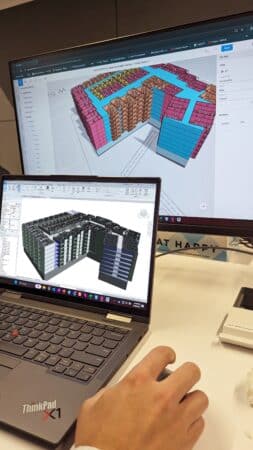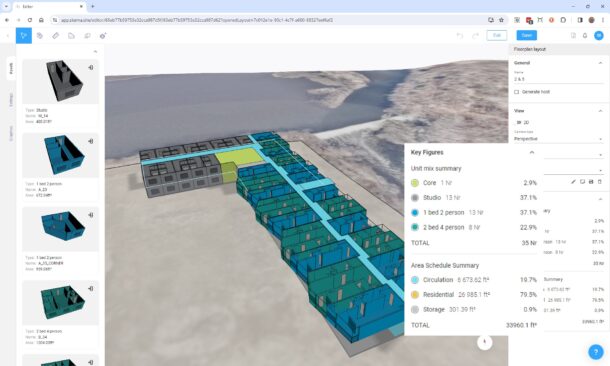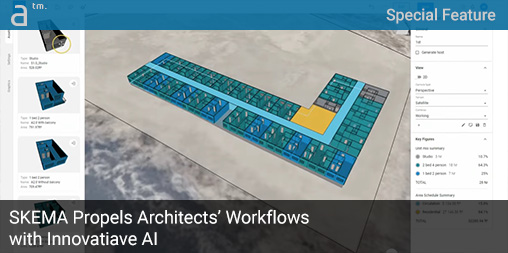THERE IS THIS BIG GAP between doing the early design work and getting to deliverables that generate a firm’s billings,” says Marty Rozmanith, co-founder and chief technology officer of SKEMA, one of the next-gen BIM software solution providers now in the market.
Sometimes referred to as BIM 2.0, SKEMA is among a new class of BIM software startups that are addressing significant pain points or missing capabilities found in today’s stalwart desktop-era BIM solutions. And they are increasingly leveraging AI (artificial intelligence) or machine learning (ML) to do so.
Essentially, SKEMA turns a firm’s current BIM system into the input data for conceptual and schematic design.
In SKEMA’s particular case, this software leverages successful design work from an architecture firm’s past and uses it to develop whole building designs much faster than traditional design methodology.
Essentially, SKEMA turns a firm’s current BIM system into the input data for conceptual and schematic design. The solution—which is completely cloud-based—”fast-forwards the design process,” helping firms win work and accelerate workflows.
The front-end conceptual design environment of SKEMA is similar, in some respects, to other BIM 2.0 tools out in the market. It will help architects more rapidly address and resolve site planning, site context, massing, and sustainability issues early in the schematic design phase while giving architects the tools they need to test pro forma metrics and establish schematic blocking and stacking for the larger components of the architectural program.
But the similarities end there. SKEMA’s design environment includes a design catalog of select units from a firm’s previous designs, with all the BIM data to back those units up during the conceptual and schematic phases.
Here, Rozmanith says his company’s technology is the only “BIM knowledge reuse engine.”

In a recent charette, a designer created this model in SKEMA in an afternoon and got the BIM in minutes with just a few clicks. (Image: SKEMA)
Once the architect is ready to move forward from schematic design, SKEMA essentially transforms your schematic designs into BIM LOD 350 models. It can do so according to your office’s standards because the SKEMA system ingests your Revit data to create the catalogs.
A basic idea behind the SKEMA platform is leveraging a firm’s acquired wisdom and expertise. If your firm has expertise in multi-family housing with innovative residential unit designs, why not leverage it during the building massing stage?
Unlocking a Firm’s BIM Investments
The short answer is: “Of course,” you want to. However, the base technical issue is that those worked-out unit plans most likely live exclusively inside a Revit BIM model and nowhere else. If your firm uses SketchUp or Rhino, you may have those unit plans in another 3D model format, but many large practices don’t.
Unfortunately, you cannot simply Copy and Paste a unit plan out of a Revit BIM model and drop it into a new blank Revit file. Walls, floors, ceilings, and other elements all have interdependencies and may traverse floor levels. And even if you could somehow do this, the units themselves wouldn’t be “smart” or “intelligent” enough to swiftly integrate into assemblies, blocks, and stacks vertically.
The data is out there, but it is very hard to use, and there are other problems associated with this data.
SKEMA addresses this missing capability in desktop-era BIM tools like Revit.
“The data is out there,” says Marty Rozmanith, “but it is very hard to use, and there are other problems associated with this data. When senior people leave a firm, often that knowledge walks out the door with them.” Rozmanith says that to solve these issues, SKEMA works to capture this knowledge infused in past successful designs and create what he calls a firm’s “greatest hits album.” “We create the catalog by analyzing the designs from a firm’s past work, unlocking a firm’s existing BIM investments.”
Using Machine Learning AI
Machine learning is a type of AI technology deployed in SKEMA. The software uses a mediating technology called a knowledge graph. There are quite a few solutions that do graphs, but SKEMA says it has a very distinct way of implementing the graphs. SKEMA turns the BIM data that represents spaces into knowledge graphs. And then, the AI analyzes knowledge graphs.
It’s this methodology that keeps the data—and the architect’s IP—separate from the AI. With the architect at the helm of this process—using an optimization technique known as “human in the loop”—this ability to apply machine learning to knowledge graphs leads to better designs. The software uses these knowledge graphs to generate a firm’s “greatest hits,” which the SKEMA folks say on their website is a custom “Design Catalog” based on the firm’s previous successful designs.
“When we first explained SKEMA to you last year at AIA National, we were not using AI to do this yet,” says Rozmanith. Instead, the firm deployed a very manual and laborious process to analyze early customers’ data and create concept catalogs for use in the general system. Once they built the catalog, customers were off to the races!
“We knew that if we wanted to scale this, we needed a fully automated process, and that is why we turned to AI to do this,” he adds.”Our primary focus is on giving architects their design catalogs so that they have control over the design process.”
To ensure the predictability of the outputs and results, the SKEMA team continues its efforts on machine learning model design, evaluation, and monitoring techniques and strategies.
At the moment, the AI/ML scans of existing buildings are done behind the scenes, and customers don’t manage that process directly. The AI/ML scanning process includes a human-in-the-loop because there is ongoing training and supervision. The SKEMA AI agent is training on various building types, including schools, healthcare facilities (which is a considerable domain), multi-family, hotels, and other types of building types/programs that are often unitized and repetitive.

The logic in SKEMA’s design catalog units remains intact as the units are morphed into new shapes and sizes. (Image: SKEMA)
When we refer to a “unit” as a multi-family residential unit, the unit is an apartment or condo unit. Marty Rozmanith uses a term more meaningful to the SKEMA team: “block.” He also uses the term “chunks.”
“The blocks or chunks that contain a firm’s knowledge may be apartment units, hotel suites, classrooms, or, in healthcare, surgery suites and nurses’ stations,” he adds.
Using SKEMA
For an architectural firm to test using SKEMA, it does not need to hand over any IP (intellectual property) tied to past designs for clients. A professional license comes with the SKEMA Community Catalog, which was created by the SKEMA team and is free of IP issues. That single license provides a single architect the ability to test the early design benefits of SKEMA, including exporting a finished concept design into a BIM LOD3X0 preview and access to Revit data integration and export.
The team license option includes use for five seats and confidential firm-specific design catalog creation using a firm’s BIM data. Regarding IP issues, Rozmanith says, “SKEMA itself does not learn from these catalogs with an ingesting AI function; the IP, therefore, stays just with the end user and is never available for any other architect.”
Morphing and BIM Acceleration
These units or blocks, derived from your past successful designs, are yours alone, but they are not static. SKEMA has “morphing” technology, another AI technology from Google that enables the SKEMA user to stretch, squeeze, and alter units to fit the overall building conditions.
“One of the main things we can do is take an apartment building layout, capture the intelligence of that layout and its relationships of spaces, and apply that to another layout in a process we call ‘morphing’ to change that unit to fit the space you have,” says Rozmanith. Building typologies with repetitive programmatic units, such as schools, healthcare, and hospitality, also apply.

When a layout doesn’t quite fit the space, SKEMA’s unique Morphing Tools let you easily squeeze or stretch your puzzle pieces, even around corners. Or create entirely new schemes just by morphing the layout into new shapes. (Image: SKEMA)
“So the ability to change size and shape and yet retain the logic and rules and patterns is one of the main things we bring to the table,” he adds. When the software does this function, it undoubtedly acts as an architectural planner, transforming the architect’s role into that of curator and evaluator. This increases the core value of the architect’s services.
In another stunning time-saving twist, once the design work is completed at a particular stage and is ready only for further tuning in a BIM authoring solution, then SKEMA BIM rapidly generates a LOD3X0 level Revit or IFC model.
SKEMA Futures
And speaking of IFC, what if your firm does not use Revit as its BIM platform?
On the output side, SKEMA BIM exports multiple Revit files, including an overall Revit building file and separate Revit files for each unit type. For example, say you are doing a multi-family project with both 1-bedroom and 2-bedroom units. And, say you use the Morph tools to modify some units at the corner of the building. SKEMA BIM exports one separate Revit file for each type of unit plus every morphed unit. And you also get a mirrored set of IFC files.
“You don’t have to use the BIM data,” says Rozmanith. “You can just use it [SKEMA] to come up with options for your building.” So, architects can benefit from two levels of acceleration. One is the AI agent-based creative workflows, and the other is transforming that directly into high-level BIM models, including those based on your firm’s standards.
In case you are wondering if only rectangular buildings work in SKEMA, Rozmanith says they will be implementing Shapediver so that you can run Grasshopper scripts inside SKEMA in the future but has yet to offer a date. While the ingestion process at the front end, where SKEMA turns selected designs into a design catalog, is best suited to Revit, it’s able to work with other file types. For example, architects using Nemetschek-branded BIM tools like Archicad and Vectorworks, the IFC functionality at the end of the process can be beneficial.
The morphing technology AI comes from Google’s AI division, and while it works well on apartment units, more advanced blocks and chunks may be more difficult. That’s where the architect’s manual design skills come in, and iterative workflows between human design and AI design can benefit each other downstream in the cycle.
Until such futures arrive, the SKEMA team continues to advance this innovative and beneficial software.



